Trout fishing tips and tricks
A little bit about trout
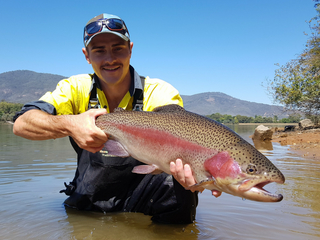 Trout is the name given to several species of freshwater fish that belong to the Salmonidae family. In Australia, we have five main types of salmonid in our waters: Atlantic salmon, Chinook salmon, brown trout, brook trout and rainbow trout. It’s worth noting that some of these species can be cross-bred to produce hybrid fish, for example brook trout can be crossed with brown trout to produce tiger trout. Stocking hybrid trout may be trialled in Victorian waters in the near future.
Trout is the name given to several species of freshwater fish that belong to the Salmonidae family. In Australia, we have five main types of salmonid in our waters: Atlantic salmon, Chinook salmon, brown trout, brook trout and rainbow trout. It’s worth noting that some of these species can be cross-bred to produce hybrid fish, for example brook trout can be crossed with brown trout to produce tiger trout. Stocking hybrid trout may be trialled in Victorian waters in the near future.
Trout have a natural distribution across North America, Europe and northern Asia. They were introduced to Australia from England in the 1860s, and later from New Zealand (in the 1890s), to help make newly settled Europeans feel more at home. While early attempts to establish the species were problematic, today they are now one of Australia’s most popular freshwater fish.
Where to find trout
Trout can be found in many lakes and rivers across Victoria. Depending on the waterway, these trout will either be stocked fish (common in many lakes) or wild fish (almost exclusively so in rivers, though there are some notable exceptions - e.g. Merri River and the Hopkins River in southwest Victoria).
Regardless of whether they’re hatchery reared or wild bred, all trout need cool, clean, well oxygenated water to thrive. From an angling perspective, this means it's often more productive to head to water at higher altitudes (such as alpine rivers and lakes) during summer, or target rivers in forested areas that offer more shade and retain good flows and depths. For lake fishing, southern or highland waters that have a depth of at least 2.5 metres can continue to provide trout with the cool water they need during the warmer months.
In rivers, depending on conditions, trout will often sit in currents next to snags or boulders where they can maintain their position in well-oxygenated water and dart out to grab passing food. In lakes, they can often be found feeding on baitfish, bugs and hatching insects in shallow areas in the morning and late evening. During the day, particularly in summer, they’ll often lie in deeper water to escape the heat, so you’ll need to get your lure or bait right down to the bottom. In hot spells, trout feed in shorter periods late in the evening and at night. Trout are less common in lowland reaches of rivers when the water temperature exceeds 20℃.
Hot spots for catching trout
In Victoria, we’re lucky to have some awesome trout fishing in a number of rivers and lakes across the state. Here are some of the best.
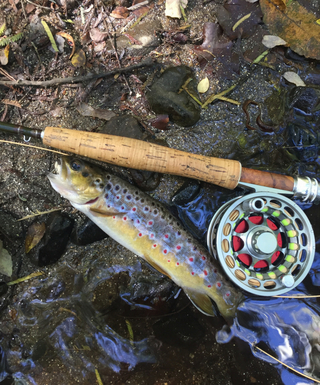
- Goulburn River (between Eildon and Molesworth)
- Rubicon River
- Acheron River
- Steavenson River
- Tanjil River
- King River
- Ovens River
- Kiewa River
- Mitta Mitta River
- Lake Catani
- Lake Eildon
- Lake Purrumbete
- Lauriston Reservoir
- Hepburn Lagoon
- Newlyn Reservoir
- Tullaroop Reservoir
- Lake Toolondo
- Lake Hume
- Lake Bullen Merri
- Lake Wendouree
- Eildon Pondage
- Lake Dartmouth
Baits and lures
Trout are aggressive, opportunistic predators that forage and eat a range of terrestrial and aquatic insects, crustaceans, small fish (including their own species!), worms, amphibians and small mammals like mice. What they decide to eat depends in large part on where they live and the time of year. For example, on some waters during certain times of year trout will feed almost exclusively on a few abundant food sources - and this means if you know what they’re eating, you can select a bait, lure or fly that looks similar.
When it comes to baits, lures, and flies there are literally thousands of options - and this can make choosing one a bit intimidating at times. So, to help you out, we’ll tackle each category separately and highlight the most popular ones. When it comes to baits, there are three main types - live bait, dead bait and dough baits.
Live bait
Worms and maggots are two types of live bait that can be very effective for trout. When fished just beneath the surface (using a little split shot sinker on the line) or unweighted on the bottom, in the right spot, the action of the worm or maggot wriggling on the hook can be very tempting to an actively feeding trout. In summer, using live grasshoppers or crickets can also be very effective.
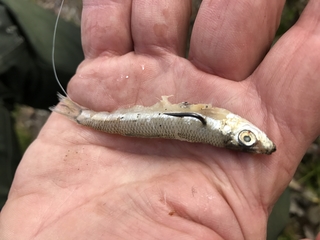 Dead bait
Dead bait
Glassies, which are small minnow fish, are a popular and effective dead bait for trout. These little fish are shiny and when they’re retrieved their colour and movement can attract trout to bite. You can buy them in frozen packs from many servos making them a convenient choice for many anglers.
Dough bait
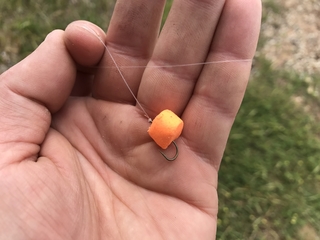 Dough baits (e.g. PowerBait) are a good option for people who don’t want to handle live baits. Dough baits feel like putty and are made to smell and taste attractive to trout. Some of them also come in loud colours like fluorescent pink or orange which can trigger their aggression or mimic seasonally available food. Dough baits are often productive when targeting lakes and impounds stocked with rainbow trout.
Dough baits (e.g. PowerBait) are a good option for people who don’t want to handle live baits. Dough baits feel like putty and are made to smell and taste attractive to trout. Some of them also come in loud colours like fluorescent pink or orange which can trigger their aggression or mimic seasonally available food. Dough baits are often productive when targeting lakes and impounds stocked with rainbow trout.
Lures
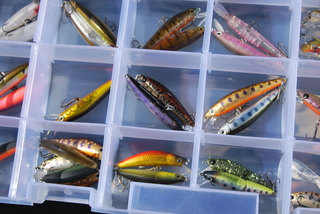 Trout can be caught on a range of lures and there is a plethora on the market. Soft plastics, hard bodies, spoons, bladed and winged lures, some are better for casting and others are better suited to trolling (towing the lure behind a boat at a distance). Some examples of popular lures for stream casting are: Rapala minnows (floating and count down), Celtas (bladed lure), and metal blades (lipless crankbaits).
Trout can be caught on a range of lures and there is a plethora on the market. Soft plastics, hard bodies, spoons, bladed and winged lures, some are better for casting and others are better suited to trolling (towing the lure behind a boat at a distance). Some examples of popular lures for stream casting are: Rapala minnows (floating and count down), Celtas (bladed lure), and metal blades (lipless crankbaits).
For trolling, winged lures include: Tasmanian Devils, Loftys Cobras and Tillins Cobras.
Advanced trolling can be quite technical and involve the use of lead lines and downriggers to present lures at depth.
Flies
Trout can also be caught using a distictive technique called fly fishing. In fly fishing, specialised rods, lines, casting methods, and ‘flies’ are used. The flies are essentially hooks tied with man-made and natural fibres that are made to look like the insects, crustaceans and other wild food trout prey on. There are thousands of fly ‘patterns’ (a term used to describe a particular type of fly) available, and while some waters or times of year require you to be highly selective, there are some essential ones that will work well in many waters and situations. For the purpose of brevity, here are our top ten essential flies: golden ribbed hare’s ear, pheasant tail nymph, stick caddis, wooly bugger, magoo, elk hair caddis, royal wulff, pale morning dun, parachute adams and a muddler.
Fly fishing is an art that can be tricky to master quickly, and it often pays to go out with an experienced fly fisher to learn the ropes. While it can be frustrating at first, once you get the hang it can be truly addictive.
(Thanks to J on Flickr who let us use the photo below under Creative Commons)
Rods
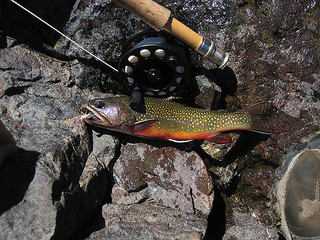 For bait and lure fishing all you need is a good quality 7 foot, 2 to 4-kilogram spinning rod matched with a 2000 sized reel. The reel can be spooled with 4 to 6 lb braid connected to a 4-6lb leader. For bait fishing, a simple running sinker rig (weighted lightly) with a 30-centimetre leader coming off the swivel and a size 6 hook will work well. For lure fishing, a similar outfit can be used – just tie your lure to your monofilament or fluorocarbon leader. Many retailers offer good value spinning rod and reel combos that range in price from $70 to $150.
For bait and lure fishing all you need is a good quality 7 foot, 2 to 4-kilogram spinning rod matched with a 2000 sized reel. The reel can be spooled with 4 to 6 lb braid connected to a 4-6lb leader. For bait fishing, a simple running sinker rig (weighted lightly) with a 30-centimetre leader coming off the swivel and a size 6 hook will work well. For lure fishing, a similar outfit can be used – just tie your lure to your monofilament or fluorocarbon leader. Many retailers offer good value spinning rod and reel combos that range in price from $70 to $150.
When it comes to fly fishing equipment, many people focus on finding a rod first. However, the best place to start is to choose the right line weight and line design for the type of trout fishing you want to do. Line weights start at 1 for the lightest style of fishing (e.g. chasing small trout in fair weather in tiny streams) and go up to 15 (e.g. chasing large saltwater species in windy conditions). Double taper, weight forward, shooting head are just some of the fly line designs that can have an impact on the cast and delivery of the fly on the water. Some line designs are better for throwing lots of line, some for presenting large or heavy flies, and some are better suited for delivering small flies delicately.
Fly rods are designed to be used with specific weighted lines and are labelled 1 to 15 to provide a guide on the right line weight to use. Fly rods can be made from different materials such as carbon fibre, bamboo, and fibreglass, and are designed with different ‘actions’ (a term used to describe how the rod bends) - all of which impact the way the rod ‘feels’ when casting and the price an angler pays! A simple, good quality freshwater fly rod and reel combination can start from $300 and run into the thousands of dollars depending on the brands and specifications selected.
If we were to recommend a fly rod that would cover most fishing situations in Victoria it would be a carbon fibre, 6-weight rod with a moderate action that’s matched with either a 6 weight-forward floating, intermediate or sinking line (depending on where you want to target trout in the water column). Due to complexities of fly equipment, we’d recommend speaking to a good fly fishing retailer about your needs before purchasing.
Fishing regulations
Unless you are exempt, a Recreational Fishing Licence is needed when fishing recreationally in, on or next to Victorian waters. So, before heading on the water we’d recommend checking whether you are exempt. Licences can be bought online.
There are bag limits, minimum legal sizes and a closed season (in certain waters) for trout across Victoria. Click here for more information on the regulations.
Responsible fish handling
If you catch a fish, it’s important you handle it responsibly to minimise stress and maximise its chance of survival if you intend to release it.
We would recommend that:
- You take a rubber knotless net and handle the fish inside the net in the water.
- Remove hooks as cleanly as possible using long nosed pliers.
- If the fish is hooked deeply in the mouth or stomach, leave the hook where it is and cut the line as close as possible to hook.
- When possible, remove the hook while the fish is still in the water.
- If you wish to take a photo, remove the fish from the net gently, support the weight of the fish near the head and under the belly with both hands, take the snap and return to the water quickly.
- Hold the fish gently in swift flowing water to force water through its gills until it has revived and is able to swim normally.
If the fish is of legal size and you intend to keep it, we recommend that:
- Dispatch fish you intend to keep immediately.
- Ice fish and store them away from sunlight, preferably in a moist bag or cooler.
See our page on responsible fish handling for more information.
Want to know which rivers have the highest abundance and biggest trout? Then download our Wild Trout Health Report Cards below.
